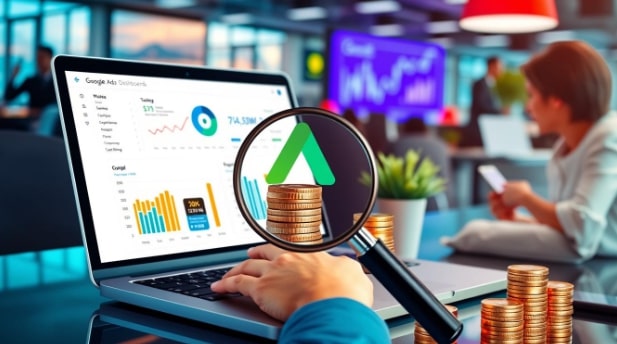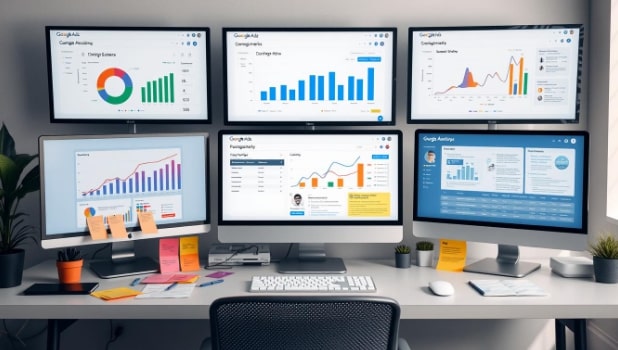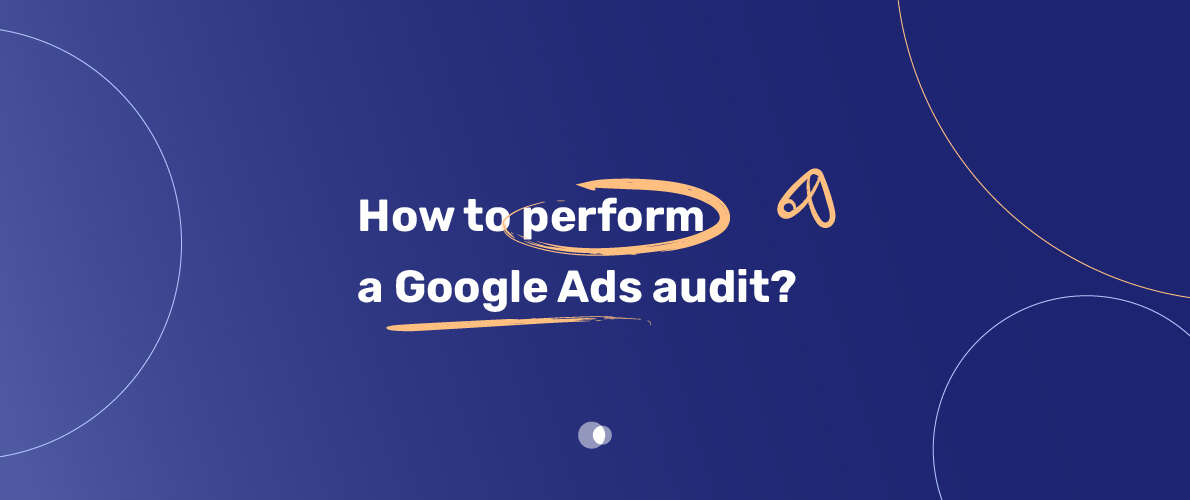In today’s digital world, managing your Google Ads account well is key. It helps you reach your marketing goals without overspending. By optimizing your Google Ads, you can get the most out of your ad campaigns. This leads to better results and more return on your ad spend (ROAS).
Table of Contents
This guide will show you how to cut costs by optimizing Google Ads account. We’ll cover important strategies and best practices. You’ll learn about cost metrics, smart bidding, and audience targeting. These techniques can help you save money and get better results for your business.

Key Takeaways
- Gain a deep understanding of the key cost metrics in Google Ads to identify areas for improvement.
- Implement smart bidding strategies to optimize your ad spend and drive better performance.
- Optimize your keyword selection and ad copy to improve Quality Score and lower cost-per-click (CPC).
- Leverage audience targeting and negative keywords to refine your reach and eliminate wasted ad spend.
- Continuously monitor and adjust your ad campaigns to keep costs in check and maximize profitability.
Understanding the Basics of Google Ads Cost Management
Google Ads can be tricky to manage, especially when it comes to keeping costs down. Knowing the main cost metrics is key to better ad budget management and higher return on investment (ROAS).
Key Cost Metrics in Google Ads
The main cost metrics to watch in Google Ads are cost-per-click (CPC) and return on ad spend (ROAS). CPC is the average cost per ad click. ROAS shows how much revenue you get for every dollar spent on ads.
Monitoring these metrics helps spot areas for improvement. It guides your decisions on how to best use your ad budget.
Common Cost-Related Challenges
- Overspending on irrelevant keywords or audiences
- Ineffective bid strategies leading to high cost per conversion
- Poor quality ad content and landing pages resulting in low click-through rates (CTR)
- Lack of granular control over ad budget allocation
Impact of Poor Account Management on Costs
Ignoring the basics of Google Ads cost management can hurt your campaign’s performance and profits. Accounts not optimized well may see higher CPC, lower ROAS, and less ad budget optimization. This can lead to wasted ad spend and lower marketing results.
“Effective cost management in Google Ads is the key to unlocking sustainable growth and profitability for your business.”
Conducting a Comprehensive Google Ads Account Audit
To cut down on costs, start with a detailed Google Ads audit. This process helps you find ways to make your campaigns more efficient. You’ll look at your account’s setup, keywords, ad content, and how well your campaigns are working.
Here are the main steps for a successful Google Ads audit:
- Check Your Campaign Structure: Look at how your Google Ads campaigns are set up. Make sure they’re well-organized and focused on specific goals.
- Study Keyword Performance: Look at how your keywords are doing. Find out which ones are working well and which ones might be costing too much.
- Review Your Ad Copy: Check if your ads are catchy and relevant. See if you can make them better to get more people to click on them.
- Examine Your Landing Pages: Make sure your landing pages are good and match what your ads say. They should make it easy for visitors to take action.
- Look at Your Bidding Strategies: Check if your bidding is working well for your goals. See if you can adjust it to save money.
By doing a full Google Ads audit, you’ll learn a lot about your account. You’ll find ways to cut costs and make your campaigns better.
| Audit Area | Key Considerations |
| Campaign Structure | Proper segmentation of campaignsAlignment of campaigns with business objectivesAccurate targeting and audience settings |
| Keyword Performance | Identifying high-performing keywordsDetecting underperforming or irrelevant keywordsAnalyzing search query reports |
| Ad Copy Effectiveness | Relevance and creativity of ad textImpact on click-through ratesAlignment with landing page content |
| Landing Page Quality | User experience and relevanceConversion rate optimizationSeamless transition from ad to landing page |
| Bidding Strategies | Evaluation of current bidding strategiesIdentification of optimization opportunitiesAlignment with campaign goals and budget |
With a detailed Google Ads audit, you’ll find ways to save money and improve your campaigns. You’ll get better results from your Google Ads spending.
Smart Bidding Strategies to Reduce Costs by Optimize Google Ads Account
Google Ads can be tricky to manage, especially when it comes to keeping costs down. Choosing between manual and automated bidding is a big decision. Automated bidding, or smart bidding, is often more efficient and cost-effective.
Manual vs. Automated Bidding
Manual bidding means setting and adjusting bids yourself. It takes time and may not keep up with market changes. On the other hand, automated bidding uses Google’s algorithms to adjust bids in real-time. It aims to meet goals like target CPA or target ROAS.
Choosing the Right Bidding Strategy
The choice between manual and automated bidding depends on several factors. These include the complexity of your campaign and how much control you want. For many, smart bidding is a better choice. It helps save time and money, allowing you to focus on other marketing tasks.
Monitoring and Adjusting Bid Performance
It’s crucial to watch how your bids are performing, no matter your strategy. You might need to tweak your target CPA or target ROAS settings. Or, you could try different automated strategies or make manual changes when needed. By being proactive, you can cut costs and improve your Google Ads results.
| Metric | Manual Bidding | Automated Bidding |
| Time Investment | High | Low |
| Adaptation to Market Changes | Slow | Fast |
| Optimization Capabilities | Limited | Advanced |
| Cost Control | High | Moderate |
Keyword Optimization and Cost Control
Effective keyword optimization is key to saving money in your Google Ads account. By finding and using the best keywords, you can cut down on unnecessary spending. This is done by using different match types and looking at search query reports.
Identifying High-Performing Keywords
First, do thorough keyword research to find long-tail keywords that fit your business. These specific keywords usually have less competition and cost less to target.
Utilizing Keyword Match Types
Google ads company has different keyword match types to manage your ad traffic. Try out broad, phrase, and exact match keywords. This helps you show ads to the right people, saving money.
Leveraging Search Query Reports
Looking at your search query reports often gives you insights. It shows you what searches trigger your ads. By adding irrelevant searches to your negative keyword list, you can save money and make your campaigns better.
| Keyword Match Type | Description | Potential Impact on Cost |
| Broad Match | Ads may show for a wide range of related searches | Potentially higher click-through rate, but higher cost-per-click |
| Phrase Match | Ads show for searches that include the exact phrase, with additional words before or after | Balanced approach, with moderate cost-per-click |
| Exact Match | Ads show only for searches that exactly match the keyword | Potentially lower cost-per-click, but smaller reach |
By optimizing your keywords, using different match types, and updating your list based on reports, you can manage costs well. This makes your Google Ads account work better.

“Effective keyword optimization is the foundation of a successful Google Ads campaign. It allows you to target the right audience and maximize your return on investment.”
Improving Quality Score to Lower Cost-per-Click
One of the best ways to cut down on Google Ads costs is by boosting your Quality Score. Quality Score shows how well your ad and landing page meet user needs. By raising your Quality Score, you can lower your cost-per-click (CPC) and make your campaigns work better.
Landing Page Relevance
Your landing page’s relevance is key to your Quality Score. Make sure your landing page matches the user’s search intent and your ad’s message. This can be done through landing page optimization, which might mean better content, structure, and call-to-action.
Ad Copy Optimization
The quality of your ad copy is also important for your Quality Score. Write ad copy that grabs attention, is informative, and matches the user’s search. This can boost ad relevance and get more users to click on your ad.
Click-Through Rate Enhancement
Your ad’s click-through rate (CTR) affects your Quality Score too. A higher CTR shows Google that your ad is valuable and relevant. To improve CTR, try A/B testing, using eye-catching formats, and making your ad copy and visuals appealing.
By working on landing page relevance, ad copy optimization, and CTR, you can optimize your Quality Score. This will help lower your Google Ads costs.
Campaign Structure and Budget Allocation
Creating a strong Google Ads strategy needs careful planning. You must organize your campaigns and manage your budget well. This way, you can make the most of your campaign organization and get better results.
Segmenting your campaigns is key. Split them into different themes or product categories. This helps target your ads better and optimize your budget. You can then give more money to your top-performing ad groups.
- Group your ad groups by specific keywords, products, or services. This keeps your targeting sharp.
- Check how your campaigns are doing often. Move your budget to the ones that work best.
- Try out different campaign segmentation methods. Find the one that gives you the best return on investment (ROI).
Learning how to organize your campaigns and manage your budget well can greatly improve your Google Ads account. The secret is to keep analyzing, adjusting, and improving your strategy. This way, your marketing will always match your business goals.

“Effective campaign structure and budget allocation are the cornerstones of a successful Google Ads strategy.”
Negative Keywords and Audience Targeting
To make your Google Ads better and save money, use negative keywords and target your audience well. By avoiding unwanted search terms, your ads reach the right people. This makes your ads more effective and saves you money.
Building Effective Negative Keyword Lists
Using negative keywords is key to saving money in Google Ads. These are terms you don’t want your ads to show up for. This stops your budget from being wasted on the wrong people.
To make a good negative keyword list, know your audience well. Look at search reports, check out your competitors, and stay up-to-date with trends. This helps you pick the right keywords to block.
Audience Segmentation Strategies
Targeting your audience well is also important for saving money. By dividing your audience by demographics, interests, and more, you can make your ads more relevant. Audience targeting helps you spend your ad budget on the people most likely to buy from you.
Geographic Targeting Optimization
Location targeting is also key for saving money in Google Ads. By seeing how your ads do in different places, you can focus on the best areas. Adjusting your location targeting regularly helps you avoid wasting money and reach the right people.
“Precise targeting is the key to maximizing the efficiency of your Google Ads campaigns. By leveraging negative keywords and audience segmentation, you can significantly reduce your cost-per-acquisition and drive sustainable growth for your business.”
Ad Schedule Optimization and Device Targeting
In the world of digital advertising, smart marketers use dayparting and ad scheduling to boost their Google Ads campaigns. They time their ads to hit when they’re most effective. This way, they get the most out of their budget and see better results.
Start by looking at your past data to find the best times and days for your ads. Use this info to adjust your bids and tailor your ad scheduling. For instance, weekday mornings might be the best for clicks, while weekends are good for brand awareness at a lower cost.
Also, device targeting is key in Google Ads management. Knowing how your audience uses your ads on different devices helps you optimize your mobile optimization. This way, you can use your budget better.
- Look at how devices perform to set the best bids for each.
- Make sure your ads and landing pages work well on mobile.
- Use device bid adjustments to spend more on devices that work best.
By mixing dayparting, ad scheduling, and device targeting strategies, you can save a lot of money. And you’ll make your Google Ads campaigns more efficient.
“Optimizing your ad schedule and device targeting is a critical step in reducing costs and driving better returns from your Google Ads investment.” – Digital Marketing Expert
Conclusion
Businesses can cut costs by using the strategies in this article. They should start with a detailed account audit. Then, use smart bidding, keyword optimization, and target the right audience.
These steps help lower costs and make your Google Ads campaigns better. The secret to lasting success is to keep checking and tweaking your Google Ads account. Look at cost metrics, quality scores, and campaign structure often.
This ensures your ads stay affordable and meet your business goals. By following these Google Ads Optimization services, cost reduction recap, and PPC management best practices, you can get more from your digital ads. This will help your business grow.
It’s important to keep up with Google Ads changes. Knowing the latest trends and practices can help your business stand out. With a smart and data-driven approach, you can save money and grow your business.
FAQ
1)What are the key cost metrics in Google Ads?
The main cost metrics in Google Ads are Cost-Per-Click (CPC), Click-Through Rate (CTR), Return on Ad Spend (ROAS), and Cost-Per-Conversion.
2)What are some common cost-related challenges in Google Ads?
Common issues include high ad costs, low campaign profits, and poor budget use. It’s also hard to find and fix overspending areas.
3)How can poor Google Ads account management impact costs?
Bad management can cause more ad spending. It also leads to lower returns and higher costs. This happens due to poor campaign setup, wrong targeting, and not optimizing enough.
4)What is the importance of conducting a comprehensive Google Ads account audit?
A detailed audit finds ways to improve, like fixing bad campaigns and targeting. It helps cut costs by making smart, data-based choices.
5)What are the key differences between manual and automated bidding strategies?
Manual bidding lets you set bids yourself. Automated bidding uses AI to adjust bids for specific goals, like Target CPA or Target ROAS.
6)How can keyword optimization help control costs in Google Ads?
Good keyword use, like long-tail keywords, can cut down on high-cost, low-value keywords. This reduces ad spending and boosts efficiency.
7)What is the impact of Quality Score on cost-per-click (CPC)?
A better Quality Score means lower CPC. This is because Quality Score is based on relevance, ad quality, and click rate. A higher score can save you money.
8)How can effective campaign structure and budget allocation impact costs?
A well-organized campaign structure and smart budget use can save money. It ensures ad spend goes to the most profitable areas, cutting costs.
9)What is the role of negative keywords and audience targeting in reducing costs?
Negative keywords and smart audience targeting prevent ads from showing to the wrong people. This reduces waste and boosts efficiency, saving money.
10)How can ad schedule optimization and device targeting impact costs?
Optimizing ad schedules and adjusting bids for devices can save money. It ensures ads are shown at the best times and on the right devices, improving efficiency.



